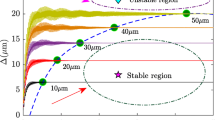Abstract
The paper investigates the dependency of residual stresses on process parameters of grinding in the quick point mode. It is evaluated whether the area-specific grinding power or energy is correlated to the residual stresses in the surface and to the maximum residual stresses in the surface layer. Firstly, the paper derives an analytical model for the area-specific grinding power and energy based on models from literature. Secondly, the residual stress distribution of workpieces machined under varied cutting conditions is depicted for each process point. It is found that the area-specific grinding energy is correlated to residual stresses whereas the area-specific grinding power is an unsuitable residual stress predictor. Due to the limited experimental scope future research should seek to validate the findings with a broader variation of process conditions in quick point grinding.







Similar content being viewed by others
References
Brinksmeier E, Aurich JC, Govekar E, Heinzel C, Hoffmeister H-W, Klocke F, Peters J, Rentsch R, Stephenson DJ, Uhlmann E, Weinert K, Wittmann M (2006) Advances in modeling and simulation of grinding processes. Ann CIRP 55(2):667–696
Brinksmeier E, Cammet JT, König W, Leskovar P, Tönshoff HK (1982) Residual stresses–measurement and causes in machining processes. Ann CIRP 31(2):491–510
Inasaki I (1987) Grinding of hard and brittle materials. Ann CIRP 26(2):463–471
Malkin S (1989) Grinding technology: theory and application of machining with abrasives. John Wiley & Sons, New York, Reprinted by SME, Dearborn
Bücker C (1997) Schälschleifen mit windschiefer Achsanordnung, Dissertation, RWTH Aachen University, Germany
Gerent O (2001) Entwicklungen zu einem ganzheitlichen Prozessmodell für das Hochleistungs-Auenrund-Formschleifen, Dissertation, RWTH Aachen, Germany
Klocke F (2009) Manufacturing processes 2, grinding, honing, lapping. Springer, Berlin
Bruzzone AAG, Costa HL, Lonardo PM, Lucca DA (2008) Advances in engineered surfaces for functional performance. Ann CIRP 57(2):750–769
Choi Y, Liu CR (2007) Spall progression life model for rolling contact verified by finish hard machining surfaces. Wear 262:24–25
Lucca DA, Brinksmeier E, Goch G (1998) Progress in assessing surface and subsurface integrity. Ann CIRP 47(2):669–693
Field M, Kahles JF The surface integrity of machined and ground hogh tensile strength steels, DMIC Report 210:54–77
Brinksmeier E (1991) Prozess- und Werkstückqualität in der Feinbearbeitung, Habilitation, University Hannover
Kruszyński BW, Wójcik R (2001) Residual stress in grinding. J Mater Process Technol 109:51–59
Zeppenfeld C (2005) Schnellhubschleifen von g-Titanaluminiden, Dissertation, RWTH Aachen University, Germany
Hinkelmann K, Kempthorn O (2008) Design and analysis of experiments, introduction to experimental design. Wiley, New Jersey
Noyan IC, Cohen JB (1987) Residual stress: measurement by diffraction and interpretation. Springer-Verlag, Berlin, p 122–123
Acknowledgments
This research and development project is funded by the German Federal Ministry of Education and Research (BMBF) within the Framework Concept “Research for Tomorrow’s Production” and managed by the Project Management Agency Karlsruhe (PTKA). The authors are responsible for the contents of this publication.
Author information
Authors and Affiliations
Corresponding author
Rights and permissions
About this article
Cite this article
Tönissen, S., Klocke, F., Feldhaus, B. et al. Residual stress prediction in quick point grinding. Prod. Eng. Res. Devel. 6, 243–249 (2012). https://doi.org/10.1007/s11740-012-0382-x
Received:
Accepted:
Published:
Issue Date:
DOI: https://doi.org/10.1007/s11740-012-0382-x



